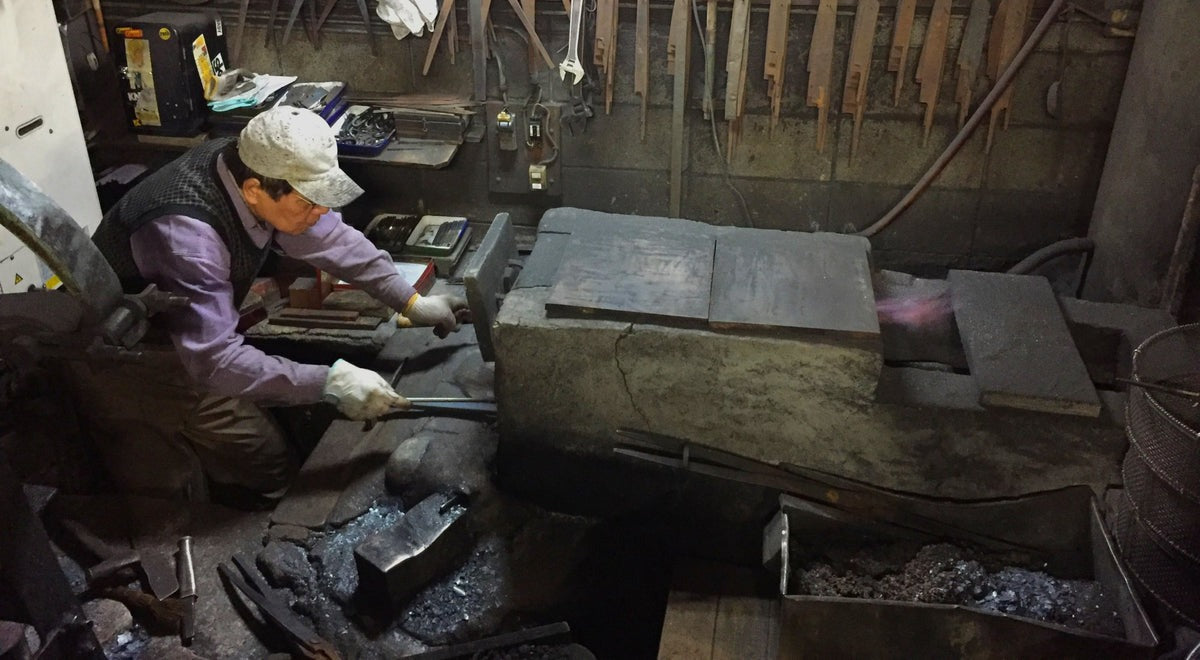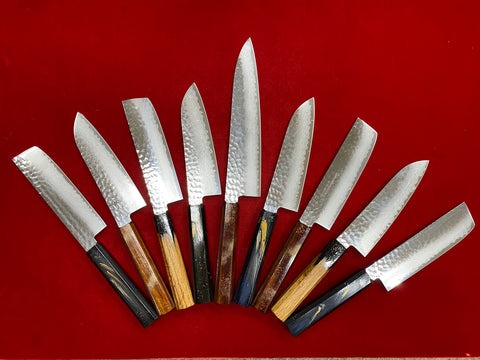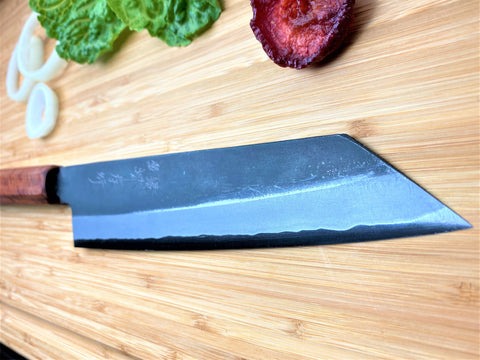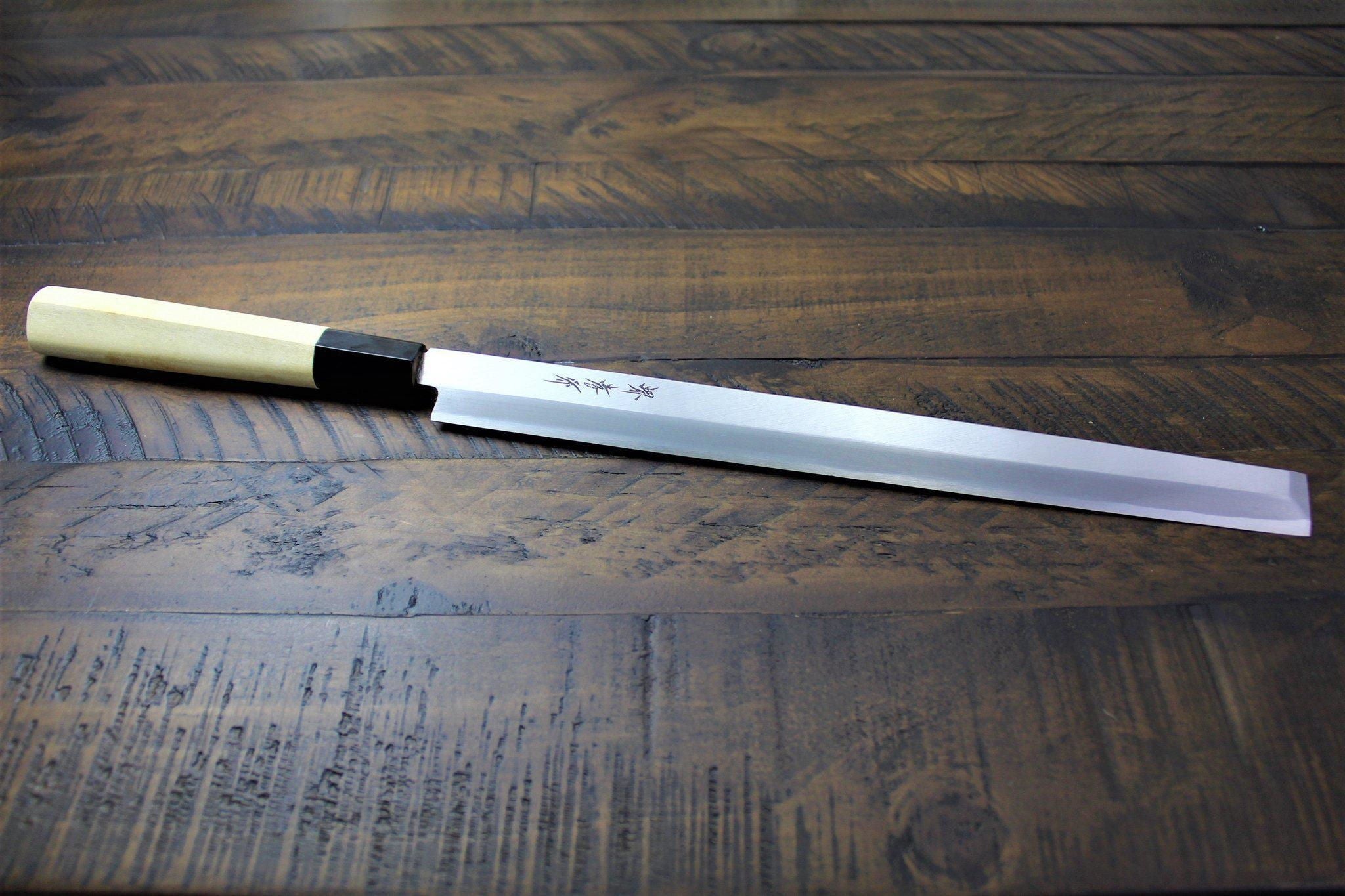
Stainless Steel Kitchen Knives vs High Carbon Steel Kitchen Knives
From samurai in ancient Kyoto to chefs in Tokyo, two metals most frequently emerge from saya—carbon vs stainless steel. When choosing the right chef’s knife, the first consideration is which will make up the blade.
Both alloys shine with the pride of the artists, blacksmiths, and warriors who came before. Like those professions, each blade features a different set of strengths. Understanding the difference between carbon vs stainless steel knives will help guide your decision and elevate your culinary skills.
What is Stainless Steel?
Stainless steel is what many of us picture when we think of steel because of its wide use. It’s an alloy of iron and carbon with a minimum of 10.5% chromium. Chromium is an element highly regarded for its strength and corrosion resistance.
The chromium oxide in stainless steel creates a protective film that prevents contact between water and iron or oxygen. The film protects blades and is ideal for kitchens where less daily maintenance and care are beneficial as they don’t require immediate attention after washing or when exposed to liquids.
High-quality stainless steel is very durable. Using the Rockwell scale (HRC), stainless steel Japanese knives generally score an HRC of 58 or higher. This HRC score indicates excellent strength and edge retention.
When choosing between carbon vs stainless steel, the chromium in stainless steel fashions a blade that requires the least maintenance. Their lack of fuss makes them an excellent choice for those taking the first steps in their knife journey. They’re also great companions for culinary enthusiasts who want a workhorse blade that needs less care.
Common Varieties of Stainless Steel
Knowing more about stainless steel, you may wonder what is an example of these hearty blades in action. You’ll find that within the category of stainless steel, there are several alloy varieties.
VG-10
VG-10 steel is a high-quality metal found in many Japanese kitchen knives. It stands for “V-series” and “Gold,” which signifies its high quality and “gold standard” quality. It has a high carbon content along with chromium, vanadium, cobalt, and molybdenum. This composition allows the steel to achieve and maintain a razor-sharp edge with an HRC of 60 or higher.
AUS-10
AUS-10, also known as Aichi AUS-10 or AUS-10V, is another commonly used steel. It has high levels of carbon and chromium and includes molybdenum, vanadium, manganese, nickel, and silicon. It is renowned for its exceptional sharpness, durability, corrosion resistance, and ease of maintenance.
Ginsan/Silver-3
One slightly less common stainless steel that makes a great kitchen knife is Ginsan, also known as Silver-3. This metal has premium levels of carbon, chromium, and manganese. With an HRC of 59-61, its sharp edges and edge retention are similar to those of many high-carbon steels. When culinary enthusiasts choose stainless steel vs carbon for their knives, they often reach for Ginsan.
Powdered Steel Alloys
New innovations in the use of powdered steel, a variety of stainless steel, has introduced many new knives that now compete with high carbon steel. These new varieties, such as SRS13 or SG2 can achieve HRCs of 64 through heat treatment.
What is High Carbon Steel?
High carbon steel knives contain more carbon versus typical stainless steel blades. Their carbon levels mean they are sharper than other kitchen knife blades but are more susceptible to corrosion.
High carbon is naturally more rigid than stainless steel, and its edge retention is excellent. This strength means you won’t have to sharpen your blade frequently. But when you do, you’ll find carbon may take some work.
Higher levels of carbon ensure that your blade is able to be sharpened to a razor's edge. The higher the carbon level in an alloy, the harder the metal. When comparing carbon vs stainless steel, carbon is stronger against abrasion. However, knives can become brittle with a higher carbon level, increasing the danger of chipping.
Because of their sharpness and strength, serious chefs usually choose carbon knives vs stainless steel. They require more attention, especially when washing, but their power and precision benefits belong in any formidable kitchen.
Common Varieties of Carbon
There are several types of steel knives with a higher carbon content vs stainless steel. These are prevalent in most Japanese kitchen knives because of their culinary advantages. Here are some examples of carbon knives serious chefs choose.
Shirogami
Shirogami, or white steel, is an alloy with high carbon levels versus its stainless steel counterparts. Very few contaminants are found within its iron. These knives can boast an impressive HRC between 61-64, making them incredibly sharp. The art of forging a shirogami blade is challenging to master, which means even blacksmiths in Sakai struggle with the steel. This makes these razor-sharp blades rare and very valuable.
Aogami
Aogami, or blue steel, is made by adding chromium and tungsten to white steel during production. This increases the hard carbide molecules, improving the steel’s toughness and edge retention. This process gives knives created with an edge as they have more durability and corrosion resistance than other carbon options. However, the addition of these minerals also makes aogami knives harder to sharpen than shirogami.
The Final Word on Carbon vs Stainless Steel
When exploring carbon vs stainless steel knives, it’s important to define your goals in the kitchen. While both materials offer quality that culinary enthusiasts can depend on, they have their own strengths to consider.
What is more important, the edges of high carbon steel or the durability of stainless steel? While carbon can retain a razor-sharp edge, it is more brittle and prone to corrosion. It requires constant care. If you have ever noticed a master sushi chef, they have a rag and wipe down their knives right after use. They do this because high carbon knives must be dried immediately after cleaning.
Stainless steel is much easier to maintain versus carbon steel. It resists corrosion and does not require immediate attention after use. However, the HRC and sharpness are often lesser than carbon options. These knives are more practical for beginners or those who want more durable tools.
Choosing between carbon vs stainless steel knives is a balancing act between sharpness and usability. Even within each steel, there are variations that will guide your culinary journey. Hasu-Seizo strives to bring you the knowledge to match our selection of hand-finished, authentic Japanese knives. To start, check out our article about the different carbon steel variants shirogami and aogami.
For more details or to check out our knives:




